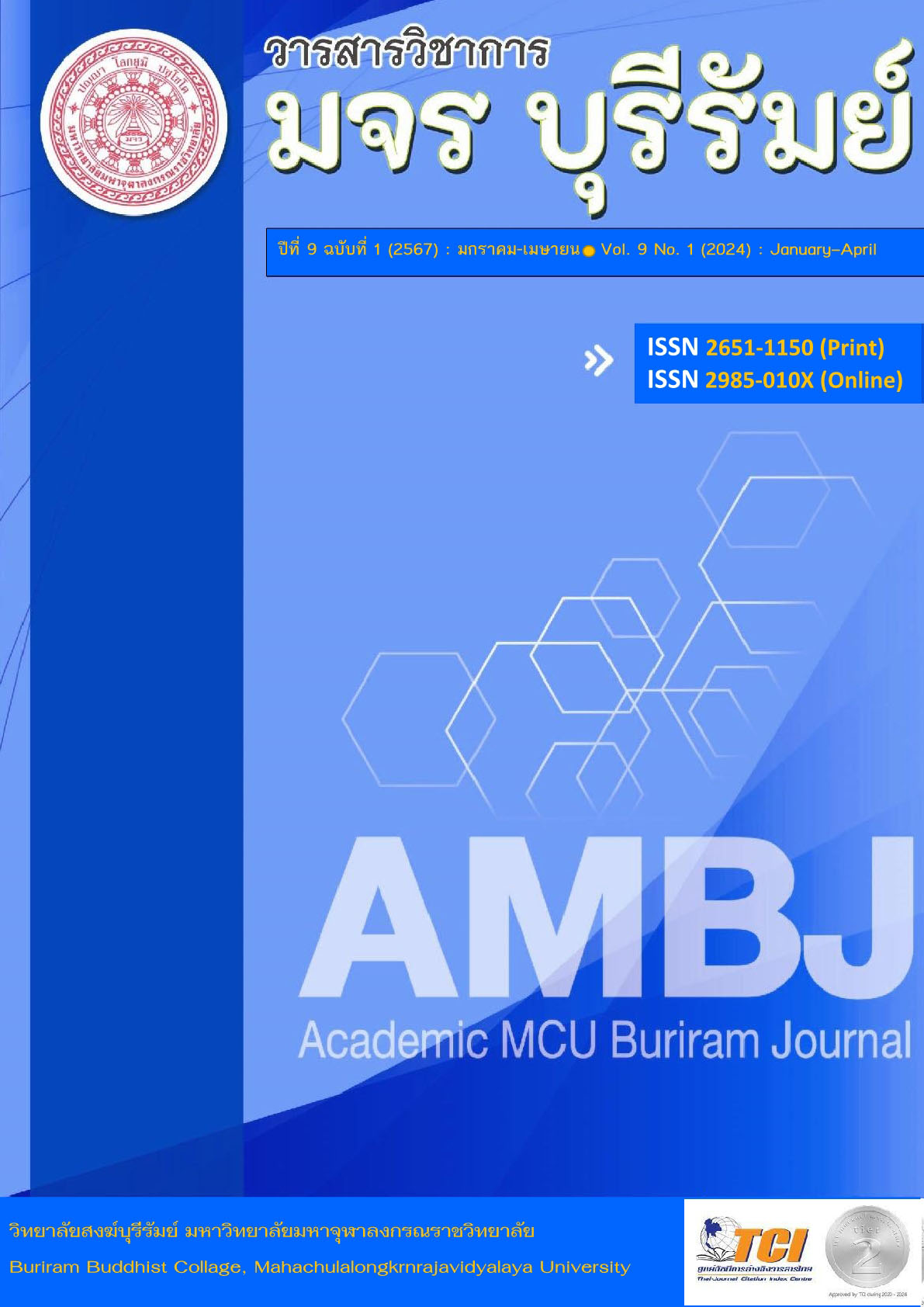An Analytical Study of the Four Foundations of Mindfulness in Anapanasati
Keywords:
Anapanasati, Satipatthana 4Abstract
The purpose of this research were: 1) study anapanasati that appears in the Theravada Buddhist scriptures, 2) study the 4 mindfulness that appears in the Theravada Buddhist scriptures, and 3) study and analyze the 4 mindfulness in anapanasati that appears in the Theravada Buddhist scriptures. It is qualitative research. Which focuses on document research by studying information from the Tripitaka, Commentary, Dika, Anudhika, Pakornvises, books, textbooks, articles, documents and related research. The data is analyzed and the results are presented in the form of descriptive analysis according to the research objectives.
The research results found that:
1. Anapanasati is an important meditation in Buddhism. The Buddha practiced the most Even on the night of his enlightenment, he practiced this meditation. Anapanasati is a process of mental development that directly affects the quality of life both physically and mentally. The Buddha expressed many suttas of anapanasati in the Tripitaka, which are complete in the anapanasati sutta. Anapanasati, when developed to a great extent, will complete the 4 satipatthanas, 7 bojjjhangas, knowledge and liberation.
2. Satipaṭṭhana 4 is the remembrance of the four foundations as the main path to complete purity. End suffering and sorrow and attain Nirvana. The principles for developing the 4 mindfulness meditations are diligence, mindfulness, and awareness. There are 4 categories: 1) Kayanupassana Satipatthana, 2) Vedanupassana Satipatthana, 3) Cittanupassana Satipatthana, and 4) Dhammanupassana Satipatthana when the practitioner has wisdom and sees the Trinity and let go of clinging and clinging and achieve the path, the result, nirvana, which is the state of finally liberation from all suffering.
3. Anapanasati, when practiced a lot, will also complete the four foundations of mindfulness. Anapanasati has 16 levels of consciousness, 4 sections. Section 1: Knowing long and short breaths, how the wind shapes the body. Make the wind condition the body to be calm, have diligence, be mindful, and have awareness. Consider the breath going in and out and the feeling of knowing the wind as a trinity. Breath is one of the bodily functions in all bodies and is classified as kayanupassana. Section 2: Knowing joy, knowing happiness, knowing joy and mental happiness. Cultivate joy and happiness that calms the mind, has diligence, mindfulness, and awareness, carefully considers the in-and-out breathing, and joy and happiness that arises from the wind are the trinity. Paying attention to the breath is one of the sensations among all sensations. Classified as Vedana Nupassana, Section 3: Knowing the Mind, Making the Mind Pramoda. Make your mind steady, release your mind, have diligence, be mindful, and have awareness. Consider the breathing in and out and the mind with various characteristics and symptoms as a trinity. Anapanasati does not exist for those who are forgetful and do not have mindfulness and awareness. It is classified as Cittanupassana. Section 4 sees impermanence, fading, extinguishing, returning. Has diligence, mindfulness, and awareness. Considers breathing in and out and things that make up the mind, the form, name, or aggregate. 5 is a trinity Focusing on the abandonment of satisfaction and dissatisfaction with wisdom is considered Dhammanupassana.
References
พุทธทาสภิกขุ. (2535). การเจริญภาวนาที่ดับทุกข์ได้ด้วยลมหายใจ. กรุงเทพมหานคร: สำนักพิมพ์ธรรมสภา.
พุทธทาสภิกขุ. (2552). คู่มืออานาปานสติ อย่างสมบูรณ์แบบ. พิมพ์ครั้งที่ 4. กรุงเทพมหานคร: สำนักพิมพ์สุขภาพใจ.
พระมหาสามารถ อธิจิตโต. (2555). ศึกษาการบรรลุธรรมด้วยการเจริญในคัมภีร์พระพุทธศาสนาเถรวาท. วิทยานิพนธ์พุทธศาสตรมหาบัณฑิต สาขาวิปัสสนาภาวนา. บัณฑิตวิทยาลัย: มหาวิทยาลัยมหาจุฬาลงกรณราชวิทยาลัย.
มหาจุฬาลงกรณราชวิทยาลัย. (2539). พระไตรปิฎก ภาษาไทย. กรุงเทพมหานคร: โรงพิมพ์มหาจุฬาลงกรณราชวิทยาลัย.
สมเด็จพระพุทธชินวงศ์ (สมศักดิ์ อุปสมมหาเถระ). (2555). อานาปานสติภาวนาลำดับการบรรลุธรรมของพระพุทธเจ้า. กรุงเทพมหานคร: ห้างหุ้นสวนจำกัด ประยูรสาส์นการพิมพ์.
สุรพล ไกรสราวุฒิ. (2554). สติปัฏฐาน 4 ฉบับวิเคราะห์-สงเคราะห์. กรุงเทพมหานคร: โรงพิมพ์จาลงกรณมหาวิทยาลัย.
Downloads
Published
How to Cite
Issue
Section
License
Copyright (c) 2024 Academic MCU Buriram Journal

This work is licensed under a Creative Commons Attribution-NonCommercial-NoDerivatives 4.0 International License.
ทัศนะและความคิดเห็นที่ปรากฏในบทความวารสารฉบับนี้ถือเป็นความรับผิดชอบของผู้เขียนบทความนั้น ไม่ถือเป็นทัศนะและความรับผิดชอบของบรรณาธิการ





